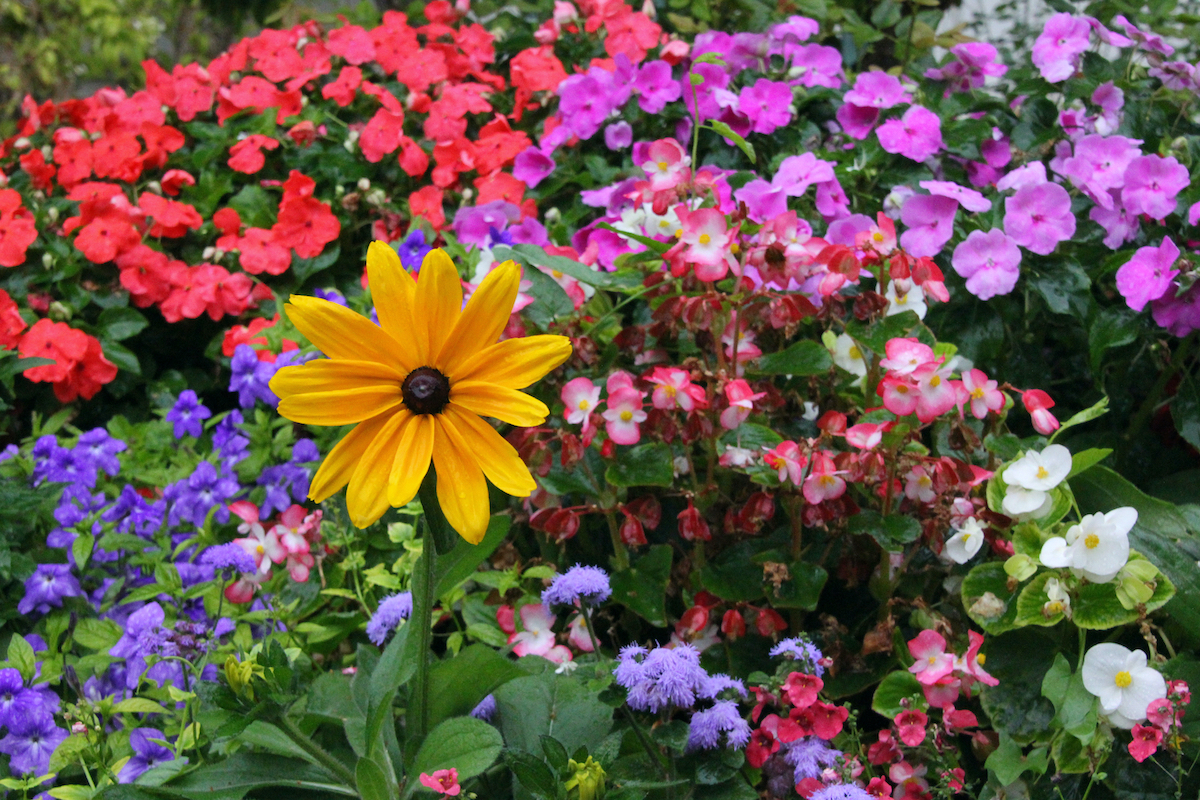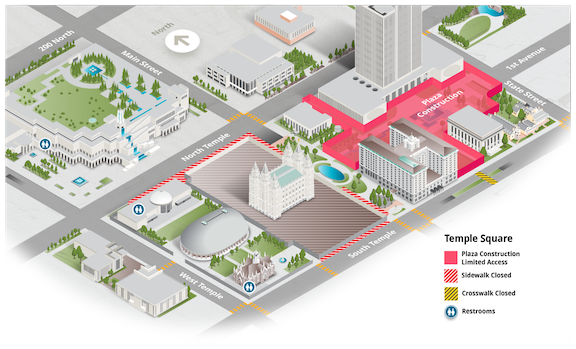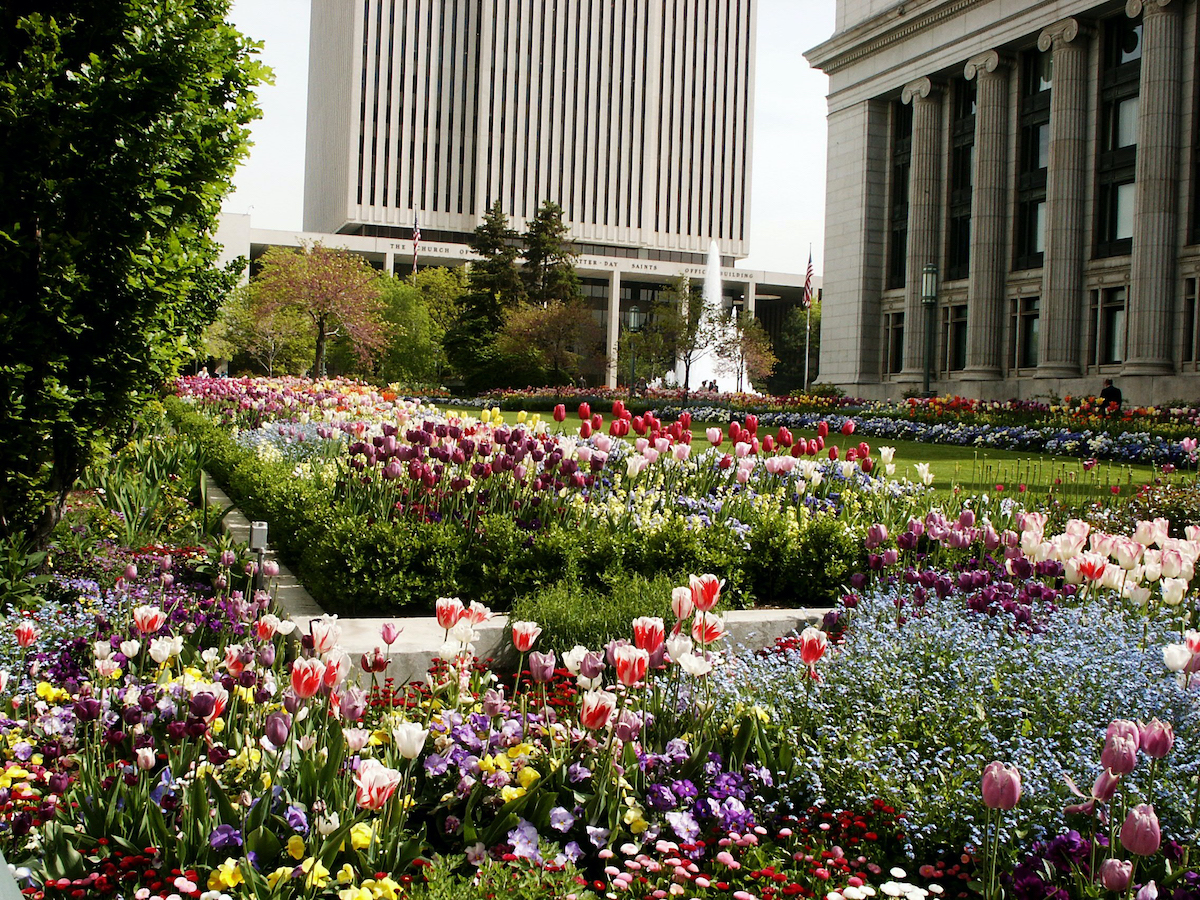Difference between revisions of "Gardens of Temple Square"
(→History of the Gardens of Temple Square) |
|||
| Line 3: | Line 3: | ||
[[Image:TS-Flowers.jpg|300px|thumb|left]] | [[Image:TS-Flowers.jpg|300px|thumb|left]] | ||
| − | The block of Main Street, known as Main Street Plaza, was purchased by the Church from Salt Lake City in 2000 features a large reflecting pool that will be continue to be featured in the design. Both the north side of Main Street Plaza and the south side opened to the public in early 2024. | + | The block of Main Street, known as Main Street Plaza, was purchased by the Church from Salt Lake City in 2000 and features a large reflecting pool that will be continue to be featured in the design. Both the north side of Main Street Plaza and the south side opened to the public in early 2024. |
A significant makeover is underway to the plaza that sits between the Church Office Building, the Church Administration Building, the Joseph Smith Memorial Building, and the Relief Society Building. The fountain will be removed and in its place will be a large circle of flags here from many nations of the world to celebrate the international nature of The Church of Jesus Christ of Latter-day Saints. | A significant makeover is underway to the plaza that sits between the Church Office Building, the Church Administration Building, the Joseph Smith Memorial Building, and the Relief Society Building. The fountain will be removed and in its place will be a large circle of flags here from many nations of the world to celebrate the international nature of The Church of Jesus Christ of Latter-day Saints. | ||
Revision as of 18:47, 20 March 2024
The gardens at Temple Square cover approximately 35 acres including Temple Square, the Conference Center and its rooftop garden, and the areas surrounding the headquarters of The Church of Jesus Christ of Latter-day Saints. The area incorporates plazas. In 2020, the gardens underwent a redesign in connection with the renovation of the Salt Lake Temple and the demolition of the North and South Visitors’ Centers.
The block of Main Street, known as Main Street Plaza, was purchased by the Church from Salt Lake City in 2000 and features a large reflecting pool that will be continue to be featured in the design. Both the north side of Main Street Plaza and the south side opened to the public in early 2024.
A significant makeover is underway to the plaza that sits between the Church Office Building, the Church Administration Building, the Joseph Smith Memorial Building, and the Relief Society Building. The fountain will be removed and in its place will be a large circle of flags here from many nations of the world to celebrate the international nature of The Church of Jesus Christ of Latter-day Saints.
The gardens have included up to 250 flower beds, 165,000 bedding plants, and more than 750 varieties of plants from more than 100 countries around the globe. Due to the Salt Lake Temple renovation project began in early 2020, many of the garden areas and planting beds have been removed or are inaccessible during parts of the project.
“Our design of the landscaping on this plaza and around the temple will open up access and views to the temple and make it more inviting for people to feel welcome here on the grounds of The Church of Jesus Christ of Latter-day Saints,” said Andy Kirby, director of historic temple renovations for the Church. Drought-resistant plants and water-wise irrigation will replace the current landscape. The Church of Jesus Christ plans on also using “historically appropriate plant types.”[1]
The Conference Center rooftop gardens represent the larger flora of the mountains and the desert valley of the Great Salt Lake area. The four-acre gardens host more than 60 different species of native wildflowers and 25 different native grasses. A prominent feature of the building is the waterfall, which starts at the base of the building’s spire on the roof and cascades down to a pool of recirculated water four stories below. When the building was proposed, then Church President Gordon B. Hinckley wanted residents living above the structure to see a garden, not a typical roof.
History of the Gardens of Temple Square
"Church leaders and members began planting trees and shrubs in the area soon after their arrival in the Salt Lake Valley in hopes of fulfilling Isaiah’s vision that “the desert shall rejoice, and blossom as the rose” (Isaiah 35:1). By the 1890s, a greenhouse was erected on Temple Square to grow flowers and shrubs that could be placed around the square. Temple architect Joseph Don Carlos Young designed a landscape in the 1880s that reflected popular landscape designs of the late nineteenth century.
"Subsequent generations of Temple Square gardeners left their own mark. Gardeners in the 1940s planted trees from all over the world—most notably, a cedar of Lebanon near the east gate to Temple Square. Gardeners in the 1970s replaced more formal planting designs with a greater variety of plants and colors throughout the gardens to bring a greater informality to the design. Several large water features were added in the 1960s and 1970s. While historically a road ran through the center of Temple Square, when the Main Street Plaza was created, it unified the entire Church campus so the gardens would run uninterrupted through two blocks. The Church Office Building plaza is currently undergoing a renovation project to beautify the grounds and direct attention to the Salt Lake Temple."[2]
Over 3 million people visit Temple Square each year and the gardens are an important part of the experience. The grounds are open for walking and viewing on your own. The gardens on the Conference Center roof are available for personal or group tours.
The gardens are maintained by full-time gardeners, seasonal gardeners, service missionaries, and volunteers who help transition the landscapes for each growing season. The effort has been directed by experts such as George Cannon Young, Irvin T. Nelson, and Peter Lassig.


